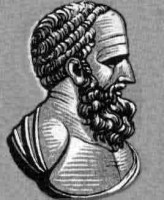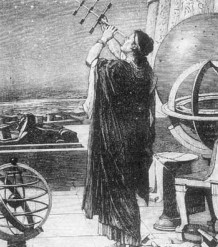
 Hipparchus was a Greek astronomer and mathematician who was born in 170 BC, and who has many astounding accomplishments to his name. He prepared the ancient world’s most accurate star map and catalogue of stars visible to the naked eye. He discovered the precession of the Earth, its wobble as it rotates. He made careful observations of the moon, enabling him to calculate the moon’s distance and size very accurately. Hipparchus was the first person to assign a scale of magnitude to indicate the apparent brightness of stars.
Hipparchus was a Greek astronomer and mathematician who was born in 170 BC, and who has many astounding accomplishments to his name. He prepared the ancient world’s most accurate star map and catalogue of stars visible to the naked eye. He discovered the precession of the Earth, its wobble as it rotates. He made careful observations of the moon, enabling him to calculate the moon’s distance and size very accurately. Hipparchus was the first person to assign a scale of magnitude to indicate the apparent brightness of stars.
Little is known of Hipparchus's life, but he is known to have been born in Nicaea in Bithynia, in what is now the country Turkey. He made his observations from places in the East as diverse as Rhodes and Alexandria. Unfortunately little of his writings have survived; most of what we know about Hipparchus comes from the Almagest, written by Ptolemy.
Let's look more closely at what Hipparchus accomplished, more than a century before the birth of Christ.

- Hipparchus discovered precession, the slow shift of the position of the stars in the sky over thousands of years due to a slight wobble of the Earth's axis. He did this after calculating the length of the year to within 6.5 minutes.
- Hipparchus assigned a scale of magnitude to indicate the apparent brightness of stars. His scale was numbered from 1 to 6, from brightest to faintest, and a version of it is still used today.
- His catalogue of 850 stars visible to the naked eye and map of the skies was so accurate that the famous modern astronomer Edmond Halley, nearly 2,000 years later, was able to compare his own map to Hipparchus', and figure out that stars have their own motions ... they change positions slowly over the centuries.
- Hipparchus can be said to have invented trigonometry, by producing the first table of values which allowed the solving of triangles.
- Using an eclipse which occurred on March 14, 190 BC, Hipparchus calculated the distance to the moon using parallax and trigonometry, to be between 59 and 67 Earth radii; this was quite amazing, as the correct distance is 60 Earth radii.
Hipparchus' achievements are all the more remarkable when you consider that a great amount of this knowledge was 'lost' over the next fifteen hundred years, much of it having to be rediscovered after the Renaissance began in the 1400's.
Resources
|

 Hipparchus was a Greek astronomer and mathematician who was born in 170 BC, and who has many astounding accomplishments to his name. He prepared the ancient world’s most accurate star map and catalogue of stars visible to the naked eye. He discovered the precession of the Earth, its wobble as it rotates. He made careful observations of the moon, enabling him to calculate the moon’s distance and size very accurately. Hipparchus was the first person to assign a scale of magnitude to indicate the apparent brightness of stars.
Hipparchus was a Greek astronomer and mathematician who was born in 170 BC, and who has many astounding accomplishments to his name. He prepared the ancient world’s most accurate star map and catalogue of stars visible to the naked eye. He discovered the precession of the Earth, its wobble as it rotates. He made careful observations of the moon, enabling him to calculate the moon’s distance and size very accurately. Hipparchus was the first person to assign a scale of magnitude to indicate the apparent brightness of stars.